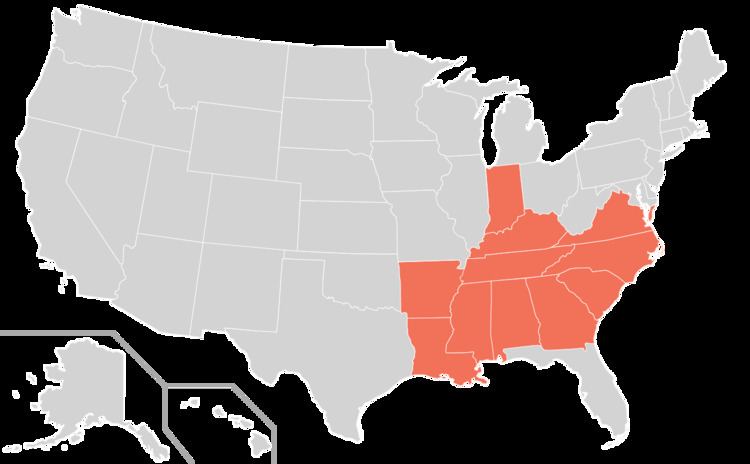 | ||
Stroke Belt or Stroke Alley is a name given to a region in the southeastern United States that has been recognized by public health authorities for having an unusually high incidence of stroke and other forms of cardiovascular disease. It is typically defined as an 11-state region consisting of Alabama, Arkansas, Georgia, Indiana, Kentucky, Louisiana, Mississippi, North Carolina, South Carolina, Tennessee, and Virginia.
Contents
- Geographic scope
- History of observations
- Hypotheses on causation
- Public health initiatives to reduce stroke incidence in the region
- Origins
- References
Although many possible causes for the high stroke incidence have been investigated, the reasons for the phenomenon have not been determined.
Geographic scope
The stroke belt is typically defined to include the states of Alabama, Arkansas, Georgia, Indiana, Kentucky, Louisiana, Mississippi, North Carolina, South Carolina, Tennessee, and Virginia. In 1980 these eleven states had age-adjusted stroke mortality rates more than 10% above the national average.
Some investigators also consider North Florida to be a part of the stroke belt, based on a stroke mortality rate higher than several states included in the region. East Texas also is characterized as a stroke belt.
History of observations
The stroke belt was first identified in 1962 by Centers for Disease Control (CDC) researchers who noted a concentration of high stroke death rates in the Atlantic coastal plain counties of North Carolina, South Carolina and Georgia. Similar high stroke rates were later observed in the Mississippi Delta region as well.
Analysis by the CDC of U.S. mortality statistics from the period 1991 to 1998 found that for both blacks and whites the counties with the highest stroke death rates were in the southeastern states and the Mississippi Delta region. Stroke death rates for states ranged from a high of 169 per 100,000 in South Carolina to a low of 89 per 100,000 in New York. While most observational studies have focused primarily on stroke incidence in adults, in 2004 researchers reported that children in the eleven stroke belt states also have an increased risk of death from ischemic and hemorrhagic stroke compared with children in other states.
Glymour et al. (2007) reported that adults who had resided in the stroke belt during childhood and had moved outside the region had higher stroke risk at ages 50 and older than adults who grew up in areas with lower stroke incidence. A study reported in 2011 found that people over age 45 living in the eight "stroke belt" states of Alabama, Arkansas, Georgia, Louisiana, Mississippi, North Carolina, South Carolina and Tennessee had an 18 percent higher incidence of cognitive decline than people in other U.S. regions. Another researcher noted that, "Stroke by itself is a major contributor to cognitive impairment and dementia." Other researchers have made similar observations.
In 2011, CDC researchers mapped the occurrence of diabetes in the U.S. by county, finding that highest prevalence of diabetes is in a "diabetes belt" that has extensive overlap with the stroke belt.
Hypotheses on causation
The causes of the elevated incidence of stroke in the stroke belt region have not been determined. Numerous possible contributing factors have been identified, including hypertension, low socioeconomic status, diet, cultural lifestyle, quality of healthcare facilities, smoking, and infections. Among the specific factors that have been proposed or studied are the following:
Public health initiatives to reduce stroke incidence in the region
The U.S. federal government has conducted public health programs specifically aimed at reducing stroke incidence and mortality in the stroke belt. In the 1990s the Stroke Belt Initiative operated in eleven stroke belt states, providing nutrition education, blood pressure screening, smoking cessation programs, weight loss programs, and other health promotion and public education initiatives targeted at stroke risk factors.
In 2004, the Stroke Belt Elimination Initiative of the U.S. Department of Health and Human Services awarded grants aimed at reducing the high incidence of stroke and high rates of stroke death and disability in the seven states with the highest rates of stroke (Alabama, Arkansas, Georgia, Mississippi, North Carolina, South Carolina, and Tennessee).
Origins
The term "stroke belt" is modeled after similar terms used for U.S. regions such as "snowbelt" and "Sun Belt", which extend the analogy to the belt as an article of clothing. The coastal plain counties of the Carolinas and Georgia — where the stroke belt phenomenon was first described, and where stroke incidence is highest — are sometimes called the "buckle of the stroke belt".
